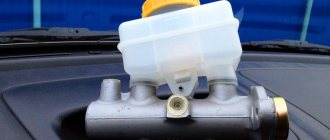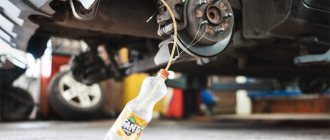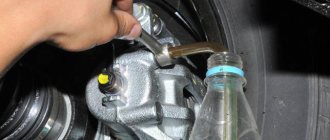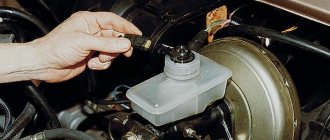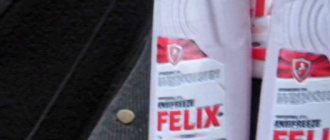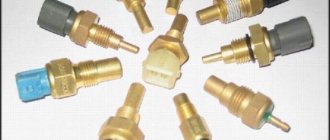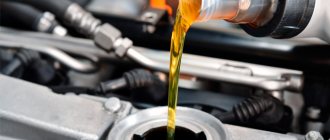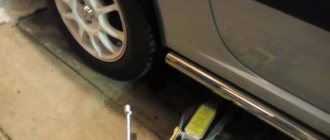The principle of braking is based on the transfer of kinetic energy from the brake pedal to the working cylinder of the wheel through brake fluid (hereinafter referred to as TF).
It is the TJ that helps reduce speed and stop the vehicle. After pressing the brake pedal, under the influence of pressure, the fuel fluid flows to the working cylinders. The brake pads compress, squeezing the disc, the car slows down and stops.
During the systematic operation of the car, the rubbing surfaces wear out and the liquid loses its useful properties. The process of replacing the TJ yourself is not complicated, but it requires attentiveness on the part of the master. It is unacceptable to disrupt the sequence of actions.
Working fluids and their volume
What and how much to fill in LADA (VAZ) 2110
Fuel tank – 43 l.
Fuel type - gasoline AI-92, AI-95. Engine oil should be changed every 10 thousand km. At the same time, a new oil filter is installed. Recommended liquid with API quality level: SG, SH, SJ. Refill volume – 3.5 l. It is also used for the crankcase of the power plant.
Antifreeze must be changed every 60 thousand km or once every two years. The following coolants are recommended: Tosol AM, Tosol A-40M, OZH-K-HT, OZH-40-HT, OZH-K-SK, OZH-40-SK, OZH-40, TOSOL-TS, AGIP ANTIFREEZE EXTRA, Glisantin G 03.
How much brake fluid do you need to change?
Maintaining the required level of brake fluid is necessary for the proper operation of the vehicle's braking system. How much is needed can always be found in the service book, but often car owners are not used to looking into it, but act empirically or look for the answer on the Internet. It is these users that we will try to help figure out the question of how much brake fluid is needed for replacement and which one should be poured.
Brake fluid is the working fluid of the brake system, with its help the force created in the master cylinder is transmitted to the wheel pairs.
If the brake fluid level is below the minimum mark (by the way, this will be indicated by the corresponding icon on the instrument panel - a red circle with waves inside), then you need to top it up. It also doesn’t hurt to check the master brake cylinder and the brake system as a whole, since a decrease in the fluid level may indicate a malfunction or wear of the master cylinder gaskets. As a rule, the brake system of a passenger car contains from 0.55 to 1.0 liters of brake fluid. And its specification can very often be indicated on the body of the expansion barrel or its cover.
When checking, do not forget to pay attention to the color of the liquid . The new TJ is transparent with a yellowish tint. During operation, it changes its color and becomes dark, this is mainly due to the accumulation of various impurities. If the fluid has darkened, this may mean that a complete replacement is necessary and simple topping up is not enough. Experts recommend replacing brake fluid approximately every 2-3 years , this is the optimal interval in accordance with hygroscopicity and exposure to temperature loads. For the brake mechanisms to function properly, the fluid must have a number of properties and also meet a certain standard.
Master cylinder with reservoir
1 – main cylinder body; 2 – low pressure sealing ring; 3 – drive piston of the “left front–right rear brake” circuit; 4 – spacer ring; 5 – high pressure sealing ring; 6 – pressure spring of the sealing ring; 7 – spring plate; 8 – piston return spring; 9 – washer; 10 – locking screw; 11 – drive piston of the “right front–left rear brake” circuit; 12 – connecting sleeve; 13 – tank; 14 – brake fluid emergency level sensor; A – gap
Master cylinder with sequential pistons. A tank 13 is mounted on the master cylinder body, in the filler neck of which a sensor 14 for emergency brake fluid level is installed. The high pressure O-rings 5 and the rear wheel cylinder rings are interchangeable.
Types and properties of fuel fluid
Old and new brake fluid
Any brake fluid has 93-98% of the main composition and from 2 to 7% of additives, which, in fact, are the key component for imparting the declared characteristics.
In general, if you look at it this way, the properties of brake fluid depend on the combination of its components. Depending on the composition of the base, TJ is divided into 3 groups.
Types of brake fluids:
- Mineral (mineral oil LHM) . They consist of alcohol and castor oil.
- Glycolic . Developed on the basis of polyglycols and their esters.
- Silicone . Manufactured from silicon-organic polymer products.
Regardless of the type and composition, all brake fluids are divided into two classifications.
Classification of TJ:
- By viscosity.
- By boiling point:
- for “dry” liquid (without water);
- “wet”, which contains 3.5% water.
If the boiling point exceeds the permissible norm, then there is a risk of a vapor lock forming in the system (as a result of moisture evaporation), which can lead to breakdown and failure of the brake pedal.
Brake fluid standards
In practice, and in most cases, it is customary to use the American quality standard FMVSS No. 116 (Federal Motor Vehicle Safety Standard), which was developed by the US Department of Transportation (DOT for short). So, often, in modern cars, either DOT 4 is used on a glycol basis, or DOT 5.1 (including glycol and silicone compounds). But in cars manufactured more than 20 years ago, BSK or DOT 3 fluid can be used.
The DOT standard clearly describes such characteristics as:
DOT 4 brake fluid (meets SAE J1703&J1704, FMVSS 116, JIS K2233, ISO 4925)
- degree of viscosity;
- boiling temperature;
- chemical inertness to materials (for example, rubber);
- corrosion resistance;
- constancy of properties within operating temperatures;
- possibility of lubrication of elements working in contact;
- level of moisture absorption from the surrounding atmosphere.
In accordance with FMVSS No. 116, brake fluid options are divided into five classes, each of which is designed for a specific type of operation and even the type of brake mechanisms - disc or drum.
But you shouldn’t think that these are uniform existing standards, because in Europe there will be SAE (Society of Automotive Engineers) J1703/1704 , ISO(DIN) 4925 - International Organization for Standardization, in the Middle Kingdom, Japanese - JIS (Japanese Industrial Standard) K2233 . But in Russia and other CIS countries there is no single standard regulating the quality indicators of brake fluids, so manufacturers work according to their own technical conditions.
Use of DOT brake fluids
Since in many cases everyone is guided specifically by the American DOT standard, let’s take a closer look at all five of its classes:
- DOT 3 – designed for low-speed vehicles with drum and disc front brakes. Boiling point 220° C.
- DOT 4 – is poured into the brake system of high-speed vehicles that have disc brakes on both axles. Boiling occurs at temperatures of 240° and 160° C.
- DOT 4+, DOT 4 SUPER – modifications of DOT 4, their boiling point is 260° C and 180° C.
- DOT 5 is a silicone fluid that cannot be poured into a car with an ABS system, because it does not absorb moisture, but allows it to collect in one place. Due to the fact that the boiling point is 280°C and 180°C (for “dry” and “wet” liquids) while having low viscosity, it is usually used only in racing cars.
- DOT 5.1 – for fast cars whose brakes are often overloaded. It is more high-tech and fluid than DOT 4, but still absorbs moisture. Often recommended for use in systems with ABS and ESP. Operating temperature 270°C and 180°C.
As for the service life of fluids of various classes, it should be noted that brake fluids of class DOT 3 have a service life of approximately 1-2 years , in turn DOT 4 - 2-3 years, and DOT 5.1 needs to be changed every 3-4 years . DOT 5 can be used for up to 5 years .
labavto.com
Replacing brake fluid (BF) is a routine operation. Manufacturers recommend changing it after 40 thousand kilometers, that is, once every few years. But those who care about traffic safety during technical inspections check the condition of the hydraulic solution and change it as necessary. The process of replacing brake fluid on a VAZ 2110 is simple, so it can be mastered by a novice motorist.
When do we change it and what type of vehicle is better to buy?
Replacing brake fluid is necessary, as it loses its quality over time. When braking, it contracts, its viscosity decreases, and it becomes thinner. In addition, TZ has the property of accumulating moisture - it is hygroscopic, so the longer the car is used without replacement, the harder it is to brake. If the moisture percentage exceeds 3.5, the fuel oil may boil, causing the brakes to fail.
Do not forget about breakdowns and mechanical damage that occur in the brake system. They cause leaks and air in the system. This cannot be allowed, as air locks reduce the effectiveness of the brakes, which can lead to an emergency on the road.
If you evaluate the condition of a hydraulic solution by its appearance, then it should be transparent, without foreign impurities. There is a special device that determines what percentage of water is contained in the total volume of hydraulic solution poured into the tank. It is expensive, but having such a tester is very convenient.
It is important not to skimp when purchasing and purchase a good liquid. The American Step Up Brands (DOT 4) has good characteristics. A worthy analogue is the TJ from the European manufacturer Mobil; its cost is cheaper than the American one. You can save money by using Russian liquid (RosDOT 4.5) and Siburneftekhim. They have good performance characteristics.
Replacing the hydraulic solution
To carry out the procedure, you need to purchase liquid for tomoses in a volume of at least one liter. Although the system will require less of it, it is better to buy it with a reserve in order to wash the parts with it. When working with TJ, you should remember personal safety, as it contains toxic substances that, if they come into contact with the skin, will damage it.
In addition, the solution is dangerous for wiring, since its chemically active components corrode the insulation of the wires. If liquid ends up on the car body, it should be wiped off immediately with a cloth soaked in cold water. The drained liquid cannot be used or poured into the sewer system; there are special points for its disposal.
To replace the solution you will need the following tools and materials:
- a set of keys;
- chemical-resistant transparent rubber hose;
- fresh hydraulic solution;
- protective gloves;
- clean rags;
- transparent containers with a volume of at least three liters.
The procedure for replacing a TJ with a VAZ 2110 consists of a sequence of steps:
- First you need to hang the wheels and remove the lock from the pressure regulator installed on the rear brakes. To do this, take a gasket or a flat screwdriver and insert it between the plate of the device and its piston, eliminating the possibility of impact. After finishing the work, you must remember to take them out.
Volume of fluid in the brake system
Basically, the brake system holds from 0.55 to 1.0 liters of fluid, this depends both on whether the car has an ABS system and on the size of the car. The period for replacing brake fluid in most cars is 2-3 years of use, or 40-60 thousand mileage . To determine a more specific interval, you need to look at a specific fluid standard and driving characteristics. For example, in sports cars the TZ is changed every 5-10 thousand.
But since the question of the required volume of brake fluid in the system and its standard is asked only by owners of ordinary cars, and not premium or business class ones, we will give specific examples for cars popular in the CIS countries.
What and how much brake fluid is in some cars
| Table of the volume of brake fluid required for replacement | |||||
| car model | DOT class | Required amount of fuel fluid, l | |||
| Ford Focus 2 | DOT4 | 1 | |||
| Ford Focus 3 | DOT4 | 1 | |||
| Ford Kuga | DOT4 | 1 | |||
| Chevrolet Niva | DOT4 | 1 | |||
| Chevrolet Cruze | DOT4 | 1 | |||
| Chevrolet Lacetti | DOT 4 | 0.5 a with ABS and ESP 1.0 | |||
| Kia Sid | DOT4 | 1 | |||
| Kia Rio 3 | DOT4 | 1 | |||
| Kia Rio 2 | DOT 4 | with ABS - 1-1.5 l without - 1 l | |||
| Kia Sorento | DOT 5.1 | 1 | |||
| Kia Spectra | DOT3, DOT4 | 1 | |||
| Renault Logan | DOT 4 | with ABS – 1-1.5 l without – 0.7 l | |||
| Renault Duster | DOT4 | 1 | |||
| Renault Fluence | DOT4 | 0,5-1 | |||
| Renault Sandero | DOT4 | 1 | |||
| Renault Megane 2 | DOT4 | 1 | |||
| VAZ 2107, 2109 | DOT 3 | 0,55 | |||
| VAZ 2114, VAZ 2115 | DOT 4 | 1 | |||
| VAZ 2108, 2110, 2112 | DOT 4 | 1 | |||
| Lada Kalina | DOT 4 | 1 | |||
| Lada Priora (VAZ 2170) | DOT 4 | 1 | |||
| Lada Granta | DOT 4 | 1 | |||
| Lada Largus | DOT 4+ | 1 | |||
| Daewoo Matiz | DOT 4 | 1 | |||
| Mitsubishi Pajero 4 | DOT 4 | 1 | |||
| Mitsubishi Lancer IX | DOT 3, DOT 4 | 1 | |||
| Mitsubishi Lancer 10 | DOT 4 | 1 | |||
| Mazda Demio | DOT 3, DOT 4 | 1 | |||
| Mazda 3 | DOT 5.1 | 1 | |||
| Mazda cx 5 | DOT 4 | 1 | |||
| Skoda Superb II | with ABS DOT 4 | 1 | |||
| SKODA Octavia A5 | DOT 4 | 1 | |||
| Toyota RAV4 | DOT 3, DOT 4 | 0,5 | |||
| Toyota Corolla | DOT 4 | 1 | |||
| Toyota Prado 150 | DOT 4, DOT 5.1 | 1,5-1,6 | |||
| Volkswagen Polo sedan | DOT 4 | 1 | |||
| Daewoo Nexia | DOT 4, DOT 5.1 | 1 | |||
| Hyundai Solaris | DOT 4 | 1 | |||
| Hyundai Accent | DOT 5.1 | 1-1,5 | |||
| Volvo XC70 | DOT 4+ | 1 | |||
| Nissan Tiida | DOT 4 | 1 | |||
| Nissan Qashqai | DOT 4 | 1 | |||
| Nissan X Trail | DOT 3, DOT 4 | 1 | |||
How much brake fluid is in the VAZ system
VAZ cars are filled with brake fluid of the DOT-4 , but its amount in the brake system can be from 550 ml in a classic (VAZ 2107) to 1.0 liters in more modern domestic cars, such as VAZ 2110 or Kalina . But if you replace the TJ with flushing, then you should take 1.5 liters, and since there is no such packaging, you will have to buy two liter bottles.
How often to change brake fluid
Useful recommendations on how often to change the brake fluid in a car. Regulations on the frequency of changing brake fluid. More details
To properly bleed the brakes, you need to know the bleeding procedure specified by the car manufacturer. However, such mistakes should not be made. More details
Bleeding the brakes without an assistant
Bleeding your brakes can be a challenging task at times. But there is a simple way to do it without an assistant. See instructions for bleeding your car's brakes yourself. Learn more.
Advice from experienced car owners
We found out how often the brake fluid is changed. Below are some warnings for experienced drivers:
- replace based on the manufacturer's recommendations;
- mix TFs within the same class (it’s better to always use the same one);
- – follow the instructions;
- there should be no H2O;
- if contaminated, prompt replacement is required;
- in a car without ABS, do not allow the fuel fluid level to reach a critically low level when pumping;
- do not create excess pressure in the expansion tank;
- Wipe the tank only with a cloth (water is prohibited).
This is interesting: The engine stalls at idle or runs unstable - what are the reasons?
When deciding to change the solution, take into account the mileage and condition of the car’s brakes. Don't forget the car manufacturer's recommendations. The shelf life of the brake fluid is limited, and it must be renewed.
If you prefer to contact a specialized service station, use Uremont. Here you will quickly find a car service suitable for your location, read reviews from aggregator visitors and receive a response to your application in an average of ten minutes.
It is convenient to clarify questions about cost in a special chat with representatives of partner car services. We work for Russia, Kazakhstan and Belarus. We provide technical support around the clock.
Is it possible to mix brake fluids?
Important! Is it possible to mix brake fluids? Due to the fact that DOT 5 uses different chemicals that are found in DOT 4 and DOT 3. Therefore, you cannot mix DOT 5 with DOT 4 or with DOT 3. Also, if the operating instructions for a particular car say that you cannot If you use brake fluid other than DOT 5, then DOT 3 and 4 cannot be poured into the brake system of such a car.
What kind of fluids and how much oil is used in the LADA VAZ 2110
VAZ 2110 car of domestic production. Popularly known as “ten”. It is a representative of a small class car. It was produced for 12 years from 1997 to 2007. Despite this, it continues to be popular among Russian drivers.
The car is equipped with several types of engines, of different sizes from 1.5 to 1.6 liters. Models produced before 2000 were equipped with a carburetor, subsequent ones with an injection system. The main advantages are high ground clearance and indestructible suspension.


